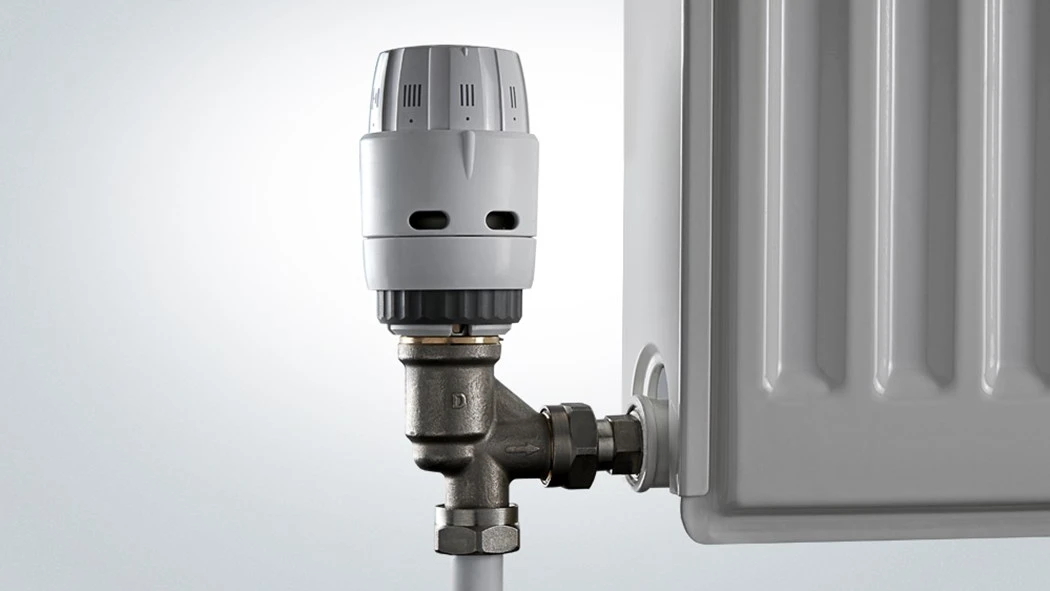A thermostatic radiator valve (TRV) is the valve on one side of a radiator that has numbered options for the desired heat in the room. Most TRVs can be fitted to either the flow or return (Danfoss RAS-C² are bidirectional angle valves) but it is best to fit to the flow when possible. Think of a TRV as an on / off tap allowing water into the radiator on demand. The numbers refer to the heat in the room and when the room temperature drops below the heat setting, the TRV will allow heat to flow through to the radiator to warm the room to the desired temperature.
0 = Off
* = 7°C
1 = 10°C
2 = 15°C
3 = 20°C
4 = 25°C
5 = 30°C
A lockshield valve is the valve fitted on the other side (normally the return side) of the radiator but like the Danfoss RA-FS valves they are also bi-directional.
How much will it cost to fit TRVs (thermostatic radiator valves)?
Replacing valves for TRVs in your home will be dependent on the amount of hours the heating engineer needs to complete the task as well as the cost of the TRVs. A good quality well known brand like Danfoss RAS-C² bidirectional angle valve can set you back £12 with it coming paired with a lockshield for as little as £18 from stores like Screwfix.
A self-balancing TRV, Danfoss RAS-B2 will cost a bit more from £23 as it is a more upmarket specialised TRV.
|
How much labour costs to fit a TRV |
Per |
Average cost |
|
Replacing a valve with a TRV |
Per hour |
£40 |
|
Upgrading for a new pair of TRV and lockshield |
Per hour |
£60 |
|
Replacing a valve with a self-balancing valve |
Per hour |
£30 |
|
Replacing 5x TRVs |
Per job |
£160 |

How do TRVs work?
The TRV is fitted to the side of the water flowing into the radiator. The valve will open and close to adjust flow of hot water into the radiator according to the temperature setting it has been set to.
The visible part of the TRV with numbers printed is referred to as the head and this sits on the valve body. The TRV works by the valve head expanding or contracting depending on the temperature which in turn adjusts the pin of the valve head allowing more or less water to flow through the valve. An expanding valve due to a warmer room, pushes the pin down, allowing for less water flow in to the radiator which will result in less heat coming off the radiator, therefore the room will cool down and once this happens the valve head will no longer expand, releasing pressure from the pin, lifting the pin, for more water to enter the radiator, to warm the radiator and therefore warm the room until again it reaches the desired temperature with the valve body expanding.
TRVs or either wax or liquid models. Liquid TRVs are the modern valves (Danfoss do liquid sensor valves) and react quicker to heat changes than the older wax TRVs.
TRV vs Danfoss Self-balancing TRV
Now that we understand how TRVs work, what is the difference between a TRV and a self-balancing TRV like the Danfoss RAS-B2? Well, the self balancing valve is a 2-in-1 being even more energy efficient than a standard TRV as it acts as a temperature control and an automatic balancing valve.
Standard TRVs only limit the flow of water but Danfoss RAS-B2 have a differential pressure controller and the balance flow pre-setting saves labour costs by quickly and easily doing this on the TRV rather than on the lockshield.
Do smart TRVs exist?
Some companies like Danfoss do smart electronic radiator thermostats (the Danfoss Eco™) where each individual room thermostatic radiator valve can be controlled via bluetooth on your smartphone in an app. This means even when you are not home, you can set an individual room to your desired heating. These TRVs are also able to be set manually for those moments where that might be easier.
Do I need to drain down my system to fit TRVs?
This depends on how many radiator valves are being changed. If you are wanting to upgrade your home to TRVs and looking to change a few radiator valves for TRVs then it will be easier to drain the water out of the heating system. Do not forget if draining down, when refilled to replenish your system with a central heating inhibitor to keep it protected from rust debris.
If you are replacing a faulty valve on one radiator, then best to change the TRV without draining down the entire system but rather releasing the pressure and draining down that radiator only. A gas engineer will be able to do this for you as it is a standard common job that they are used to doing in most homes due to replacing faulty valves or old leaky valves and upgrading older valves for modern TRVs.
Should I have TRVs on every radiator?
As TRVs can reduce the cost of energy bills, it is worth having them fitted to most rooms in the house to avoid paying for energy to heat rooms that are not used often. There should be one radiator in the home that is on permanently when the heating is switched on, without being heat adjusted by having a TRV attached to it.
Normally, people leave a bathroom radiator / towel rail without a TRV fitted to it or if there is a radiator near the thermostat, better to cleave that off from TRVs because a TRV on a radiator near the thermostat can leave the thermostat getting confused at whether it has reached temperature or not, and this might cause the thermostat to signal to the boiler to stay on longer giving and wasting more heat.